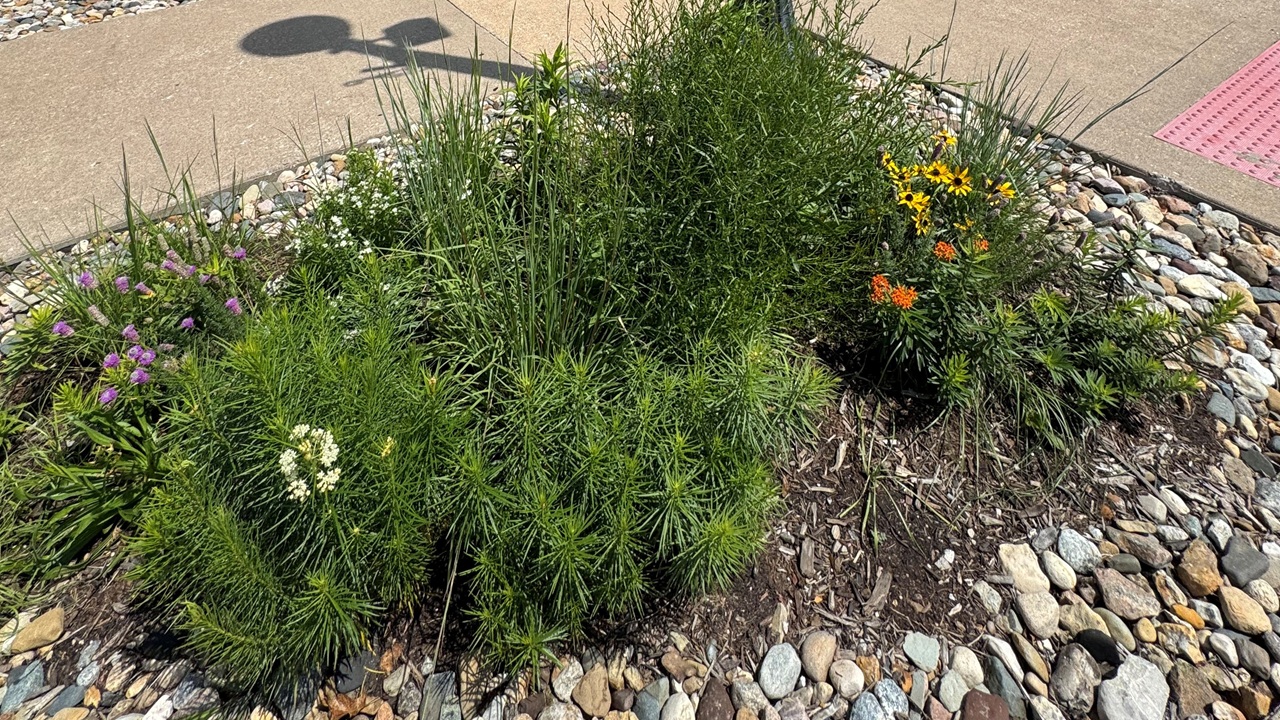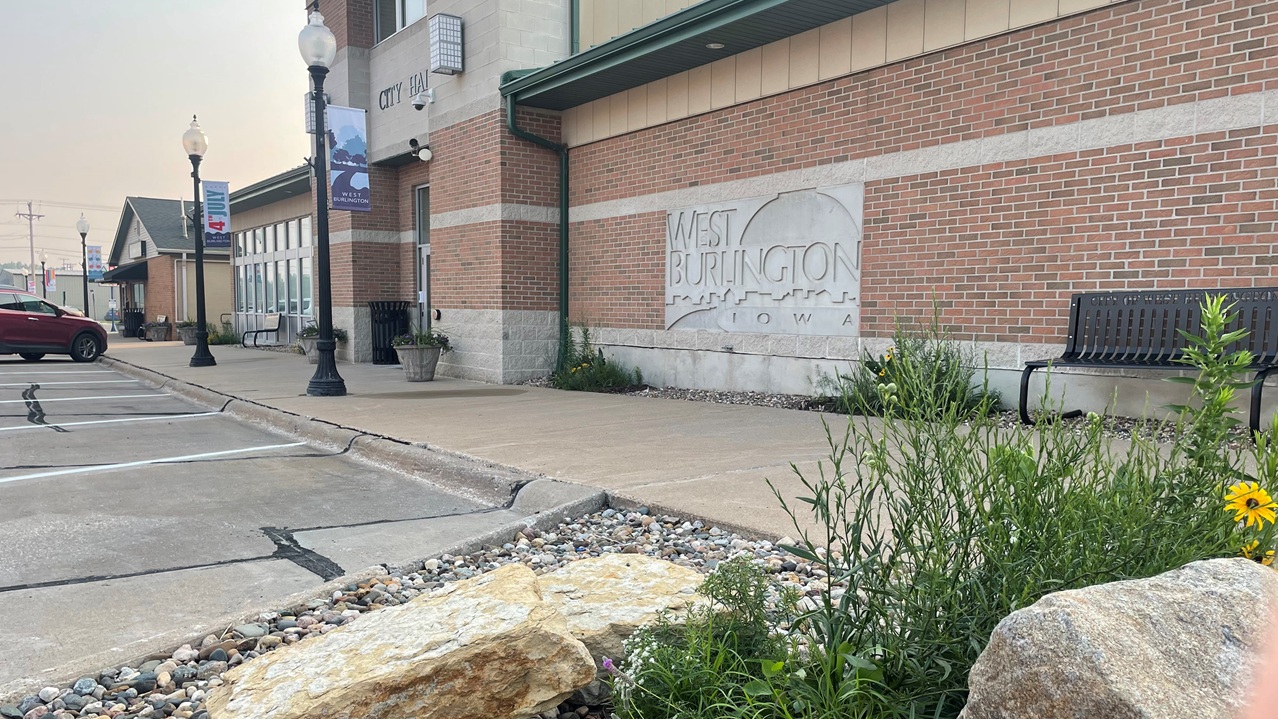
In West Burlington, a meaningful transformation is taking root—not just in our soil, but in our vision for the future. Across our community, native prairie plants and grasses are being planted in parks, along trails, and even around our wastewater treatment plant.
The city has launched several native prairie and pollinator park projects, transforming public spaces into thriving habitats for pollinators with resilient native plants, all while creating places for community enjoyment. These micro prairies and pollinator parks aren’t just beautiful; they’re purposeful. They reflect a commitment to sustainability, habitat restoration, and practical stewardship of city resources.
A Grassroots Effort with Big Impact
This work is rooted in partnerships—with local experts, passionate volunteers, and organizations like the University of Iowa’s Institute for Sustainable Communities (IISC). Through this growing network, we’ve created something uniquely West Burlington: a city-led, community-supported approach to conservation and smart land use.
We’ve teamed up with Sam Hollingsworth of Prairie Roots for prairie design and installation, while master gardeners from the community generously gave their time to help get the plants in the ground. City staff, particularly from public works, have been essential in site preparation, mulching, watering, and maintenance. Together, we’re proving that even small urban projects can have meaningful environmental and social benefits.
Where It’s Taking Root
We’ve launched several prairie initiatives across the city:
City Hall and Trail Micro Prairies
Compact, densely planted gardens featuring native grasses and wildflowers. These vibrant sites were designed in partnership with Prairie Roots and installed with help from local volunteers and city staff.
Pat Kline Park
A larger prairie restoration designed by IISC students and faculty, including Professor Mike Fallon. Their work included research, design, and community outreach—culminating in a new kind of park that prioritizes ecology and education.
Wastewater Treatment Plant
Native habitat has been added both inside and outside the plant’s perimeter. A short walking path allows residents to explore this natural space and see native wildflowers in bloom and pollinators in action.

Why Native Plants?
Native plants like milkweed, coneflowers, little bluestem, and black-eyed Susans are well-adapted for Iowa’s soil and climate, offering a sustainable and efficient alternative to traditional turf grass. Native plantings are far more resilient and require less water, mowing, and maintenance once established. Their deep root systems:
- Help retain soil and prevent erosion.
- Improve water infiltration and reduce runoff.
- Store carbon and support healthier air and water.
- Survive droughts and extreme weather.
By shifting from turf to prairie in select public spaces, we’re saving time, fuel, and money—freeing up resources for other city needs, such as road repairs and community projects.
Beyond their practicality, prairies are essential to restoring biodiversity. They provide vital habitat for pollinators—bees, butterflies, birds, and other species whose populations are declining due to habitat loss and pesticide use. By integrating prairies into our public spaces, we’re helping pollinators thrive while improving soil health, filtering stormwater, and reducing maintenance costs. In a time of increasing environmental challenges, small local actions like these help build resilience.
Supporting Pollinators, Naturally
Pollinators are critical to ecosystems and agriculture, yet many are under threat. Cities like West Burlington can play an important conservation role by restoring native habitats in public spaces. Our plantings include a wide range of species that bloom from early spring through late fall, beautifying the city and ensuring a continuous food source for pollinators throughout the growing season.
Education Through Nature
Educational signage will soon be added to each prairie site, highlighting what’s growing, why it matters, and how residents can engage with these spaces. We hope these natural areas will not only enhance beauty and biodiversity but also inspire learning—serving as living laboratories for local students, scout troops, gardeners, and nature lovers.
Whether you’re walking the trail, watching butterflies, or just enjoying a quiet moment outdoors, these spaces offer something for everyone and demonstrate our shared responsibility as stewards of the land and city resources.
A Model for Sustainable Growth
West Burlington’s prairie and pollinator projects are a testament to what’s possible when cities think long term and work collaboratively. With thoughtful planning and community partnerships, we’re making the most of our public spaces—saving resources, supporting wildlife, and enhancing quality of life.
By restoring a piece of Iowa’s natural landscape, West Burlington is investing in both its environment and its future, creating healthier spaces for generations to come.
As we continue to grow as a community, we’re doing so in a way that respects and restores Iowa’s natural heritage. Our small prairies may not cover vast acres, but they carry a big message: that sustainability starts at home, and that every square foot of native habitat matters.

GREGG MANDSAGER, ICMA-CM, is city administrator of West Burlington, Iowa, USA.
New, Reduced Membership Dues
A new, reduced dues rate is available for CAOs/ACAOs, along with additional discounts for those in smaller communities, has been implemented. Learn more and be sure to join or renew today!
